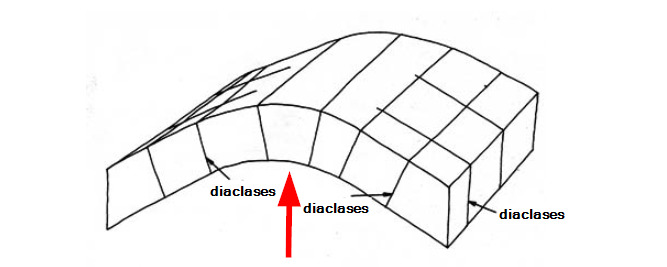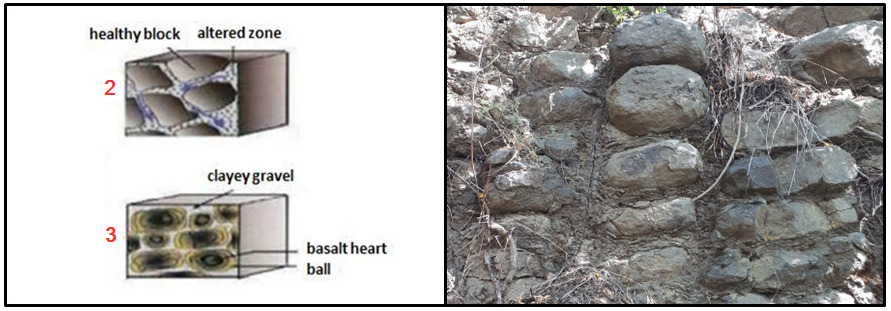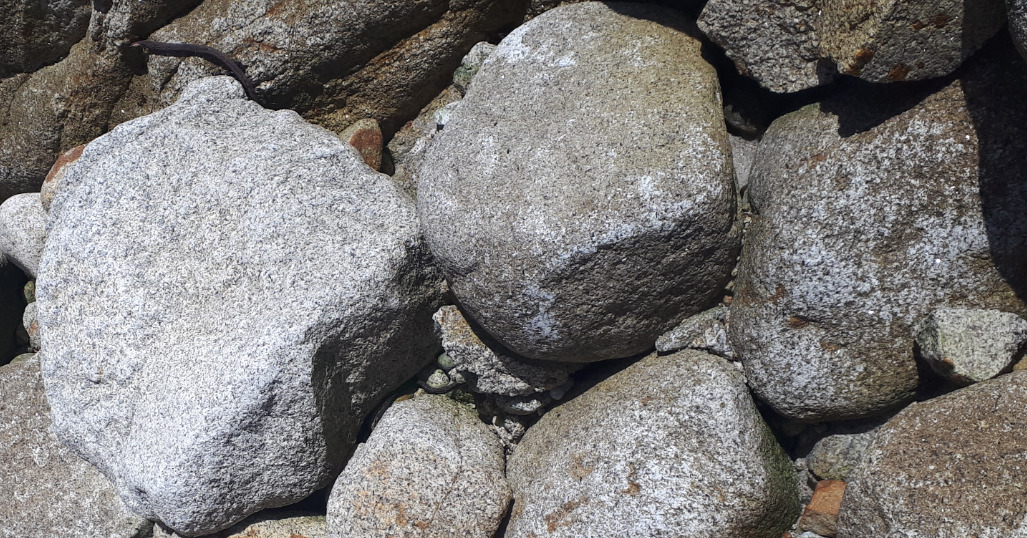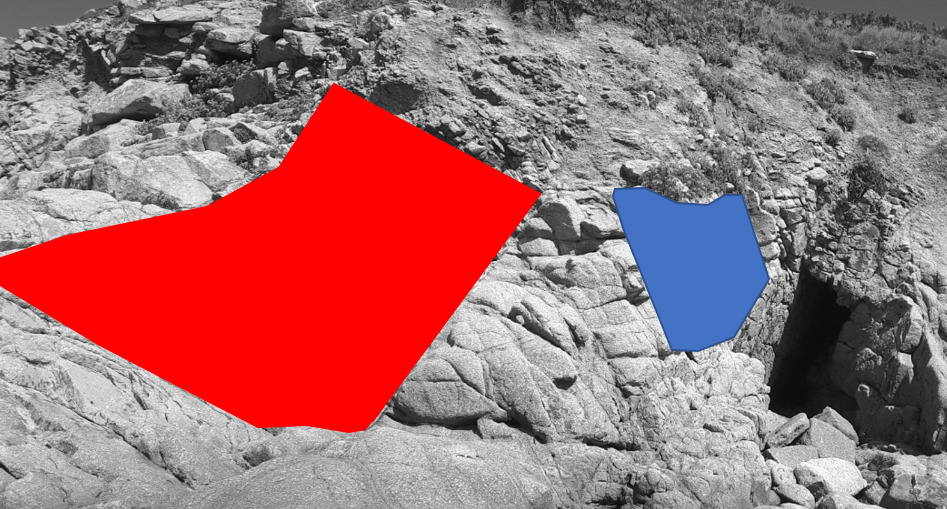
La Earthcache / The Earthcache
► Contexte géologique local
Dans la partie nord de la plage de Porz Tévigné prend place une formation de granite de Plouarzel.

Comme tous les granites, ce leucogranite est une roche QFM :
- Quartz (minéral gris translucide).
- Feldspath plagioclase sous forme d'albite (minéral blanc).
- Mica blanc (muscovite), minéral brillant blanc nacré en feuillets.
- Micas noir (biotite), minéral brillant noir sous la forme de traces.

Cette roche plutonique est grenue, homogène et normalement sans strate orientée.
Mais certains structures visibles à Porz Tévigné pourrait nous en faire douter.
► Le granite de Plouarzel, une roche litée ?
Vues dans leur ensemble, certains affleurements granitiques semblent présenter des strates comme il est souvent possible d'en voir dans une formation sédimentaire.

Ces strates apparentes sont dues à la présence de diaclases parallèles entre elles.
Une diaclase désigne le résultat d'un épisode au cours duquel une roche se fend sans que ses parties disjointes s’éloignent l’une de l’autre (ni déplacement, ni remplissage).
Dans un ensemble granitique, la roche cristallisée est peu ductile ce qui la rend très sensible à des contraintes tectoniques qui vont transformer un massif monolithique en une juxtaposition de blocs séparées par des diaclases souvent en damiers.

Au delà de cette pseudo-stratification, ces diaclases joue un rôle prépondérant dans les mécanismes d'altération d'un massif plutonique.
► Altération chimique d'un granité
Homogène et très cohérent, un massif granitique est par nature peu sensible à l'altération.
La présence de diaclases fragilise cependant cet ensemble en permettant une infiltration de l'eau, élément au fort pouvoir d'altération chimique par hydrolyse (oxydation en présence de CO2 dissous).
Chacun des minéraux du leucogranite de Plouarzel réagit différemment à cette altération par l'eau :
- Le quartz (SiO2) est inaltérable et fournit le sable des plages.
- La muscovite s’altère peu et se transforme en séricite puis en kaolinite.
- L'albite est assez sensible et se transforme en argiles :
NaASi3O8 + 8 H2O → Al(OH)3 + 3 Si(OH)4 + Na+ + OH-
- La biotite est très sensible et se transforme en oxydes ferriques et argiles :
2 K(Fe,Mg)3AlSi3O10(OH)2 + 17 H2O → Si2O5Al2(OH)4 + 6 FeO(OH) + 4 Si(OH)4 +2 K+ + 2 OH-
Une frange de teinte rouille apparaît alors le long des diaclases où l’eau s’est infiltrée par diffusion des oxydes ferriques issues de l'hydrolyse.
Ce phénomène est le premier stade de la dégradation du massif granitique.

► Les falaises nord de Porz Tévigné, une usine à boules
Au second stade de dégradation, nous passons à une altération sphéroidale.
Les intersections des diaclases (sommets et arêtes des parallélépipèdes) deviennent les zones les plus touchées et les coins s'arrondissent tandis que la partie centrale reste peu touchée.
On observe alors sur les falaises de véritables usines de production de blocs altérés arrondis sous la forme de débits bien alignés verticalement « en pile d’assiettes ».
Les diaclases s'élargissent et une mosaïque de blocs individualisés se met petit à petit en place.
Au troisième stade de l'altération, les blocs de granites arrondis se dégagent au fur et à mesure que l'arène granitique (reste des minéraux non altérés) est enlevée par l'eau ou le vent.

Au quatrième et dernier stade, les boules de granite se détachent et chutent au pied de la falaise.

► Local geological context
In the northern part of Porz Tévigné beach takes place a formation of Plouarzel granite.
Like all granites, this leucogranite is a QFM rock:
- Quartz (translucent gray mineral).
- Feldspar plagioclase in the form of albite (white mineral).
- White mica (muscovite), pearly white shiny mineral in layers.
- Black micas (biotite), black shiny mineral in the form of traces.
This plutonic rock is coarse, homogeneous and normally without an oriented stratum.
But certain structures visible in Porz Tévigné could make us doubt it.
Seen as a whole, certain granite outcrops seem to present strata as it is often possible to see in a sedimentary formation.
These visible strata are due to the presence of joints parallel to each other. A diaclase is the result of an episode in which a rock splits without its disjointed parts moving away from each other (neither moving nor filling).
In a granite group, the crystallized rock is not very ductile, which makes it very sensitive to tectonic constraints which will transform a monolithic massif into a juxtaposition of blocks separated by joints often in checkerboards.
Beyond this pseudo-stratification, these joints play a preponderant role in the alteration mechanisms of a plutonic mass.
► Chemical alteration of a granita
Homogeneous and very coherent, a granite massif is by nature not very sensitive to weathering.
The presence of diaclases however weakens this assembly by allowing water to infiltrate, an element with a strong power of chemical alteration by hydrolysis (oxidation in the presence of dissolved CO2).
Each of the minerals in Plouarzel's leucogranite reacts differently to this alteration by water:
- Quartz (SiO2) is unalterable and provides beach sand.
- Muscovite changes little and turns to sericite and then to kaolinite.
- Albite is quite sensitive and turns into clays:
NaASi3O8 + 8 H2O → Al (OH) 3 + 3 Si (OH) 4 + Na + + OH-
- Biotite is very sensitive and transforms into ferric oxides and clays:
2 K (Fe, Mg) 3AlSi3O10 (OH) 2 + 17 H2O → Si2O5Al2 (OH) 4 + 6 FeO (OH) + 4 Si (OH) 4 +2 K + + 2 OH-
A rust-colored fringe then appears along the joints where the water has infiltrated by diffusion of ferric oxides resulting from hydrolysis.
This phenomenon is the first stage in the degradation of the granite massif.
► The northern cliffs of Porz Tévigné, a boules factory
At the second stage of degradation, we pass to a spheroidal alteration.
The intersections of the diaclases (vertices and edges of the parallelepipeds) become the most affected areas and the corners are rounded while the central part remains little affected.
On the cliffs, we can then observe veritable factories producing rounded weathered blocks in the form of well aligned vertically "stacked plates" outlets. The joints widen and a mosaic of individualized blocks is gradually put in place.
At the third stage of weathering, the rounded granite blocks emerge as the granite arena (remaining unaltered minerals) is removed by water or wind.
At the fourth and last stage, the granite balls break off and fall at the foot of the cliff.
► Sources bibliographiques / Bibliographical sources
Les Questions / The Questions
La lecture attentive du descriptif de la cache, ainsi qu'une observation des éléments de terrain et un peu de déduction sont normalement suffisants pour répondre aux questions de cette EarthCache.
A careful reading of the description of the cache, as well as observation of terrain features and some deduction is usually sufficient to answer questions of this EarthCache.
Questions pour valider :"Strates et usines à Boules à Porz Tévigné"
Questions to validate: "Strata and Boules factories in Porz Tévigné"
!!! ATTENTION A LA MAREE !!!
!!! WARNING TO THE TIDE !!!
Avant de vous y aventurer, consulter l'horaire des marées :
Before you go, check the tide schedule:
Horaires des marées pour Plouarzel.
- Question 0 : Prenez une photo de vous ou d'un élément vous identifiant avec la côte.
Cette photo devra au choix nous être transmise avec les réponses ou être ajoutée à votre log.
-Question 0 : - Question 0: Take a photo of yourself or something that identifies you with the coast.
This photo must either be sent to us with the answers or added to your log.
Vous voici devant les falaises de la partie Nord de la plage de Porz Tévigné (photo WP1).
Here you are in front of the cliffs of the northern part of Porz Tévigné beach (photo WP1).

- Question 1 : Décrivez la formation rocheuse sous la zone rouge. Quelles formes particulières se distinguent et de quoi s'agit-il ? Peut-on parler de roche litée au sens géologique du terme ? Justifiez votre réponse.
- Question 1 : Describe the rock formation below the red zone. What particular shapes stand out and what are they? Can we speak of bedded rock in the geological sense of the term? Justify your answer.
- Question 2 : Quelle couleur prennent ces formes particulières ? A quel minéral est-elle dû et de l'altération de quel cristal QFM provient ce minéral ?
- Question 2 : What color do these particular shapes take? To which mineral is it due and from the alteration of which QFM crystal comes this mineral?
- Question 3 : A quelle stade d'altération se trouve la falaise sous la zone bleue ? Comment s'appelle cette forme d'altération et que va t-elle donner au final (observez le pied de la falaise)?
- Question 3 : At what stage of alteration is the cliff below the blue zone? What is this form of alteration called and what will it give in the end (look at the foot of the cliff)?
Vous pouvez vous loguer sans attendre notre confirmation,
mais vous devez nous envoyer les réponses en même temps soit par mail via notre profil (
fafahakkai), soit via la messagerie geocaching.com (Message Center).
S'il y a des problèmes avec vos réponses nous vous en ferons part.
Les logs enregistrés sans réponses seront supprimés.
You can log this cache without waiting for our confirmation, but you must send us the answers at the same time, by e-mail via our profile (fafahakkai) or by the system of Message Center of geocaching.com.
If there is a problem with your answers we will notify you. The logs recorded without answers will be deleted.
Rappel concernant les « Earthcaches »: Il n'y a pas de conteneur à rechercher ni de logbook à renseigner. Il suffit de se rendre sur les lieux, de répondre aux questions ci-dessus et de nous renvoyer les réponses.
Reminder concerning "Earthcaches": there is neither a container to look for nor a logbook to sign. One need only go to the location, answer to the differents questions and send us the answers.